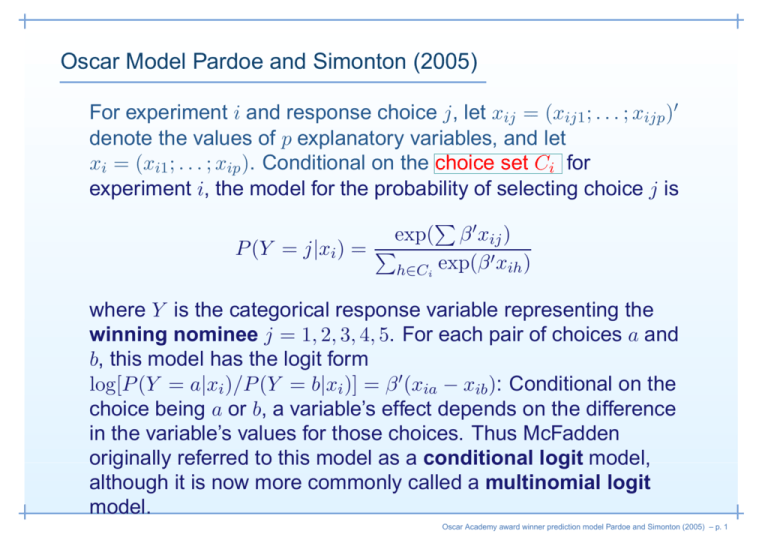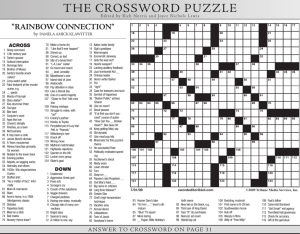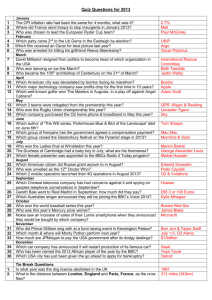Oscar Model Pardoe and Simonton (2005)
advertisement

Oscar Model Pardoe and Simonton (2005) For experiment i and response choice j , let xij = (xij1 ; . . . ; xijp )′ denote the values of p explanatory variables, and let xi = (xi1 ; . . . ; xip ). Conditional on the choice set Ci for experiment i, the model for the probability of selecting choice j is P ′ exp( β xij ) P (Y = j|xi ) = P ′ h∈Ci exp(β xih ) where Y is the categorical response variable representing the winning nominee j = 1, 2, 3, 4, 5. For each pair of choices a and b, this model has the logit form log[P (Y = a|xi )/P (Y = b|xi )] = β ′ (xia − xib ): Conditional on the choice being a or b, a variable’s effect depends on the difference in the variable’s values for those choices. Thus McFadden originally referred to this model as a conditional logit model, although it is now more commonly called a multinomial logit model. Oscar Academy award winner prediction model Pardoe and Simonton (2005) – p. 1 Explanatory xij for Leading Actress category (a) Indicator for Best Picture Oscar nomination [1939-2004]. Only 25 actresses have won the Best Actress in a Leading Role Oscar for a movie that did not receive a Best Picture nomination (most recently, Charlize Theron for Monster in 2003). (b) Natural logarithm of the number of previous Best Actress in a Leading Role Oscar wins [1938-2004]. 24 percent of Best Actress Oscar nominees with no previous lead actress wins have won the Oscar, whereas 13 percent of Best Actress Oscar nominees with one or more previous lead actress wins have won. This variable has been log- transformed because it is highly skewed. (c) Indicator for winning a Golden Globe for Best Actress in a Leading Role (Drama) [1944-2004]. Of the 62 Best Actress Oscar winners from 1943 to 2004, 31 had won a Golden Globe for Best Actress (Drama) a few weeks earlier. (d) Indicator for winning a Golden Globe for Best Actress in a Leading Role (Musical or Comedy) [1952-2004]. Of the 55 Best Actress Oscar winners from 1950 to 2004, 11 had won a Golden Globe for Best Actress (Musical or Comedy) a few weeks earlier. (e) Indicator for winning a Screen Actor’s Guild award [1996-2004]. Of the 11 Best Actress Oscar winners since 1994, eight had already won a SAG award. Oscar Academy award winner prediction model Pardoe and Simonton (2005) – p. 2 xij for all 4 categories: picture, director, acting (M/F) (a) Indicator for the first front-running movie [1938-2004]. This variable allows for the possibility that the chance of a nominee winning an Oscar could be linked to the fortunes of other nominees for the same movie. Each year there are often a handful of movies considered to be the Oscar front-runners|movies with multiple nominations in the more high-profile categories (including picture, director, and acting). The indicator variable then identifies the top front-runner as the movie with the highest nomination score, and takes the value one for all nominees associated with this movie. (b) Indicator for the second front-running movie [1959-2004]. This variables identifies the movie with the second highest nomination score, and take the value one for all nominees associated with this movie. (c) Indicator for the third front-running movie [1959-2004]. This variables identifies the movie with the third highest nomination score, and take the value one for all nominees associated with this movie. Oscar Academy award winner prediction model Pardoe and Simonton (2005) – p. 3






